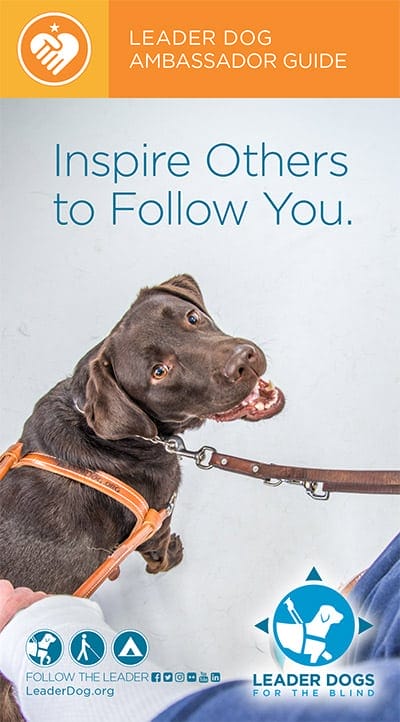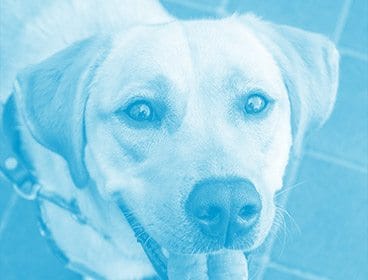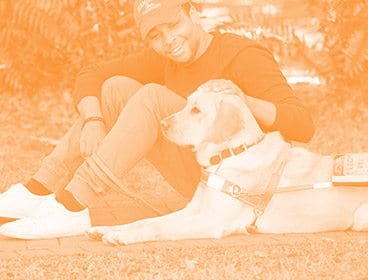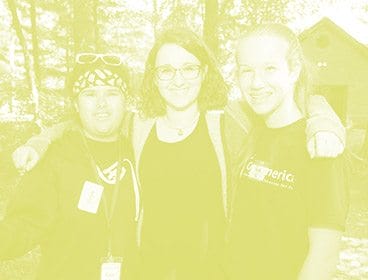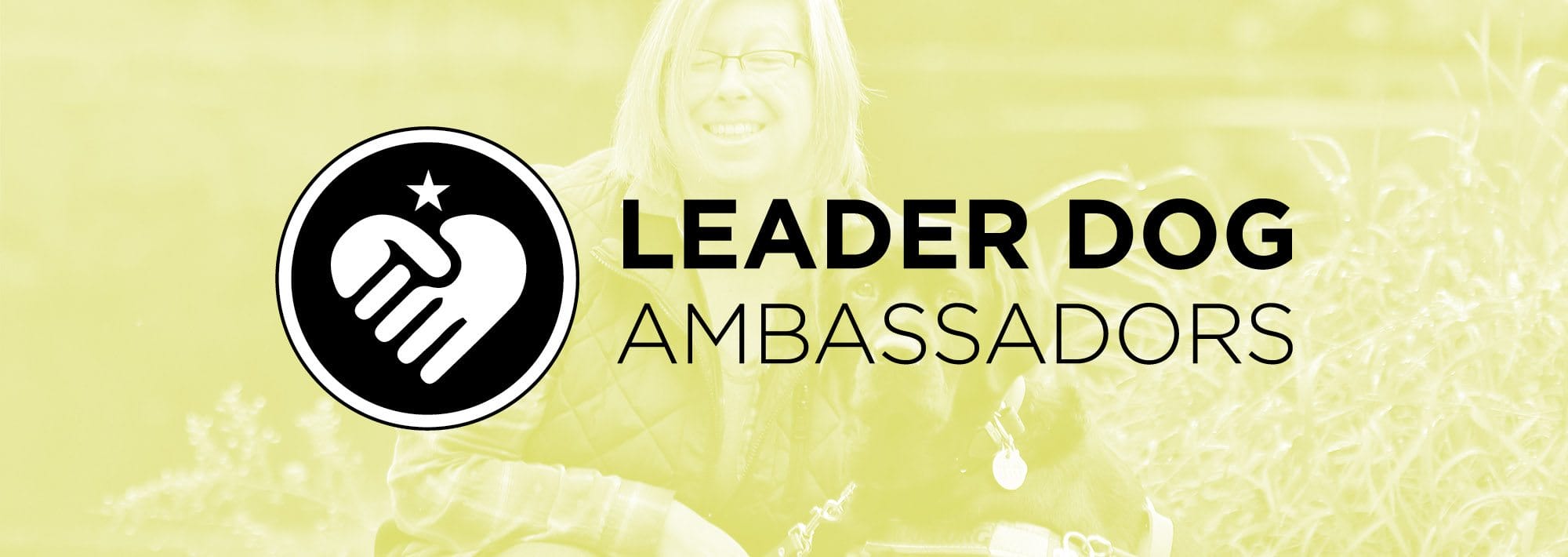
Be an Ambassador
Spread Our Message. Change Lives.
Leader Dog’s mission would not be possible without your commitment to our organization. To sustain our efforts for years to come, it is important for more people to know about Leader Dog. Our goal is for everyone who encounters us to understand:
- Our mission
- What we stand for
- Why we matter
- How we do what we do better than anyone
Together, we need to communicate a consistent message to family, friends and the surrounding communities. The kind of message that sparks a conversation, ignites passion and motivates people to take action.
As a result, Leader Dog will be able to continue to impact the lives of people who are blind or visually impaired, extend our outreach to new areas and build a bigger community of supporters.
Through this Ambassador page, we will provide you with the tools and information to help us succeed.
Video Library
Client Stories
Programs at Leader Dog
How We Help
CONFIDENCE & INDEPENDENCE
Every year, 75,000 people become blind or visually impaired in the United States. When this occurs, people who were once independent must now rely on others for assistance in daily tasks.
→
CONFIDENCE & INDEPENDENCE
After receiving white cane training or guide dog training, our clients regain their sense of independence and their confidence. They are no longer afraid to walk down the street alone.
EMPLOYMENT
Due to the daily travel limitations, 60% of working age U.S. adults who are blind are unemployed. This causes financial hardship and can have negative psychological effects.
→
EMPLOYMENT
The boost in confidence and travel skills gives many clients the momentum needed to further their education or use mass transit to get to a job interview.
HEALTH & WELLNESS
People with vision loss have a greater risk of health and wellness issues, and 43% live with depression. Many stay home, resulting in social isolation, little physical exercise, family stress and multiple health conditions.
→
HEALTH & WELLNESS
With a newfound confidence and ability to travel independently, clients can once again–or perhaps for the first time ever–live a healthy lifestyle, which benefits mental and physical well-being.
FAMILY & COMMUNITY
When someone loses their vision, the impact is far reaching. Family, friends and community often fear for their loved one’s safety and well-being.
→
FAMILY & COMMUNITY
The ability to travel safely allows clients to reconnect with their community and provides peace of mind to their family and friends.
Help Us Make a Difference
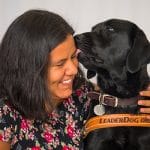
Just graduated from the guide dog course and I loved my experience. Trainers are so supportive and resident assistants are caring. I met so many volunteers and employees from Leader Dog and the passion is evident. And not to mention I made some new friends from my class and my Leader Dog is absolutely amazing!
Juanita Lillie and Leader Dog Baylor
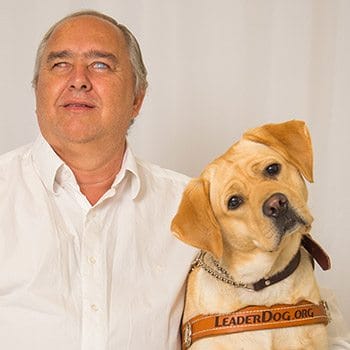
Really cool her name is Freedom because that's what it means to have a guide dog. The cane was freedom for 30 years but the dog changes that freedom dramatically!
Francisco De Lima and Leader Dog Lady Freedom
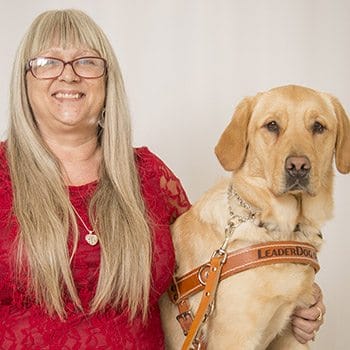
I have had a fear of stairs for as long as I've been going blind. [Leader Dog Willow] actually gave me the courage to take on a double flight of stairs after having a major panic attack trying to go down one step. So hooray for Willow and me! Thank you LDB for everything you stand for and do.
Jackie Hollenbeck and Leader Dog Willow
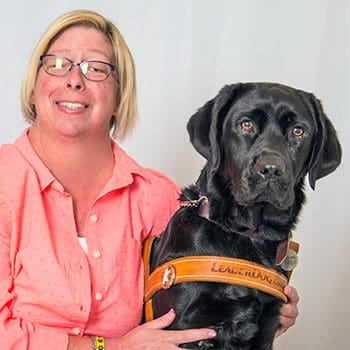
Leader Dog is a great place! I did more of my O&M training in March 2015 and today I'm leaving with my Leader Dog Lady! The staff, instructors are all great! Thanks Leader Dog! This place is the best place to come if you are blind or visually impaired! Now that I have Lady, I can walk with confidence and independently!
Dawn Rudolph and Leader Dog Lady
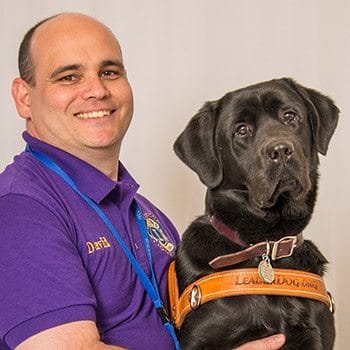
Changed my life. To be able to reclaim independent, safe travel is great. Can't imagine my life without my new Leader Dog Shadow.
David Chase and Leader Dog Shadow
Leader Dog Fast Facts
- There are currently over 1.3 million people in the U.S. who are blind or visually impaired who can become more independent by receiving mobility training.
- Leader Dogs for the Blind provides services to people who are blind or visually impaired that increase their travel independence and empower them to lead a more productive and fulfilling life.
- Leader Dog was incorporated in 1939 and its first class consisted of four people.
- Today, Leader Dog runs 11 guide dog classes per year with up to 20 clients in each class.
- Typically, clients attend a residential program lasting up to 21 days; however, we also offer home delivery, urban training and other options.
- Leader Dogs spend the first year of their lives with volunteer puppy raisers, who are responsible for teaching them basic obedience and social and house manners as well as exposing them to life experiences. Dogs return to campus between 12–15 months of age for at least four months of formal training with qualified guide dog mobility instructors (GDMI) prior to being matched with a client.
- Approximately 200 client/guide dog teams graduate annually. In 2019, Leader Dog had 1,496 active client/guide dog teams throughout the US (935) and other countries (561).
- Leader Dog does not receive federal or state funding and receives no payments from insurance companies. Leader Dog relies on voluntary contributions to fulfill its mission. All services provided by Leader Dog are completely free to our clients, including room and board and travel.
- Leader Dog was the first guide dog organization to develop a dedicated program to train people who are deaf and blind to work with a guide dog.
- Leader Dog operates 38 vehicles to transport instructors, dogs and client/guide dog teams to training locations.
- Utilities to maintain the campus run about $300,000 annually (down from $310,000 due to higher efficiency).
- The Leader Dog food service department prepares approximately 62 meals per day, using 1,095 dozen eggs, 1,381 pounds of beef, 1,255 pounds of chicken and 596 loaves of bread annually.
- The 101,000 square foot canine development center can house up to 350 dogs and puppies at one time.
- Currently, the dogs and puppies housed in the canine center require 57,000 pounds of dog food annually.
- 450–500 puppies are born each year that will be raised to become potential Leader Dogs.
- Leader Dog has placed dogs in 50 states, 10 provinces and 39 countries and have served more than 15,000 guide dog clients—and more than 16,730 clients overall.
- A Leader Dog generally works for an average of eight years, or 3,000 days.
- There are currently over 1.3 million people who are blind and partially sighted in the U.S. alone who can become more independent if they receive mobility training.
- 200 Leader Dogs and clients are matched every year.
- Leader Dogs for the Blind was incorporated in 1939 and our first class consisted of four people.
- Today, Leader Dog runs 12 guide dog sessions per year with up to 24 clients in each class.
- Most guide dog clients attend our three-week, on-campus program. Some clients receive home-delivered dogs and training to accommodate time and travel limitations. Other clients receive urban training in Chicago or warm weather training in Florida, depending on what suits their lifestyles, health concerns or other factors. Some clients receive a blend of on-campus and home training.
- Dogs are trained for four months prior to being matched with a client. Dogs for clients who are both deaf and blind receive extended training.
- There are more than 15,000 graduates in 49 states, 7 provinces and 31 countries.
- Utilities to maintain the residential program cost about $430,000 annually.
- The 65,000 square foot kennel space houses up to 315 dogs.
- The average inventory of dogs requires in excess of 122,000 pounds of dog food annually.
- The Leader Dog food service team prepares approximately 170 meals per day and uses 2,000 dozen eggs, 1,800 pounds of beef, 3,000 pounds of chicken and 1,200 loaves of bread annually.
- Our Deaf-Blind program was established in 1991. It was created by a Leader Dog team member who recognized the need; he is recognized nationally as a pioneer in this field.
- On average, six people who are Deaf-Blind graduate each year. Nearly 100 people have graduated from the program since its inception in 1991.
- Leader Dogs for the Blind has two instructors who communicate with clients in tactile American Sign Language (“reading” hands are gently placed over “speaking” hands to feel the sign language).
- Leader Dogs in this program are trained to understand and respond to both verbal commands and sign language hand signals.
- Leader Dogs prepared for Deaf-Blind clients receive up to six months of training (as compared to four months for “standard” Leader Dog training).
- Leader Dogs assigned to Deaf-Blind clients are hand-picked by the specialized instructors. These dogs are chosen for appropriate attention to the handler and their ability to assume a greater amount of responsibility.
- Deaf-Blind clients complete a three-week on-campus training program at Leader Dogs for the Blind. The client to instructor ratio is 1:2 (as compared to 1:6 for “standard” class).
- During class, clients learn how to care for and communicate with their Leader Dog. Clients learn how to travel safely with their new partner as a Leader Dog team.
- In 2002, Leader Dog began offering our free Orientation & Mobility (O&M) Training program for adults wishing to quickly improve their travel skills.
- The program was created when Leader Dog employees recognized that many prospective guide dog clients were being turned away because they did not have sufficient O&M skills to navigate successfully with a guide dog.
- Clients who take part in O&M Training do not have to be planning to get a guide dog. About 50% of O&M Training clients return to get a Leader Dog.
- The O&M Training program is only a week long. It was designed to aid in rapid improvement of cane mobility skills without a lengthy disruption to clients’ lives.
- The training covers many areas of O&M including:
- Using a white cane
- Utilizing a human guide
- Using your orientation skills and cardinal directions (north, south, east, west) to know where you are, where you want to go, and how to get there
- Solving problems along your route (barriers, crowds, etc.)
- Crossing both narrow and wide streets safely
- Re-orienting yourself, or “what to do when you get lost”
- Shopping, soliciting assistance when needed, and more
- Clients train in a wide variety of environments that they experience in daily life such as residential, semi-business, business, city and country settings.
- 80% of training takes place outdoors and 20% is completed indoors learning how to navigate things like elevators, escalators and moving sidewalks.
- Like our Guide Dog Training program, O&M Training is a residential program, so clients live on our campus in Rochester Hills, Michigan during the week of training.
- Summer Experience Camp is our residential summer program for 16- and 17-year-olds. It's headed by our team of certified orientation and mobility specialists.
- Campers stay at our beautiful campus in Rochester Hills, Michigan and enjoy day trips in the surrounding area.
- Our facility includes a dining room, large screen television room, music room, library with accessible books and movies, outdoor pavilion and 24/7 Leader Dog staff. Each camper’s private room is complete with a bathroom, television, telephone, internet access and mini refrigerator.
- All Summer Experience Camp attendees receive a free GPS device and instruction in how to use it.
- Campers practice using GPS as they complete many fun activities including tandem biking, kayaking and socializing with other campers.
- Campers have the opportunity to experience working with a Leader Dog. For many campers, this is their first time navigating with a guide dog.
- Leader Dog pays for all costs associated with the program including travel to and from Leader Dog's campus, the GPS device, housing, meals, activities and related training.
- Staffed with two full-time veterinarians and two veterinary technicians
- Approximately 30 physicals are performed each day
- 50–60 x-rays are taken each week
- 450–500 spays and neuters are performed each year
- State-of-the-art equipment is used, e.g.:
- Ultrasound: for imaging internal structures of the abdomen and for pregnancy diagnosis
- Laser: for soft tissue surgery to decrease pain and provide for bloodless surgery
- Digital radiograph unit: for enhanced detail and image manipulation of radiographs and to increase efficiency in diagnosis of medical conditions
- Digital dental radiology: for greater detail and image enhancement in dental care
- Endoscope: for noninvasive gastrointestinal (GI) care and artificial inseminations
- Advanced dental care is provided, including root canals, pulp caps (alternative to root canal), orthodontic appliances and surgery
- Care is provided for:
- Breeding
- Birthing (whelping)
- Puppies
- Leader Dogs in training
- Working Leader Dogs
- Veterinarians are able to perform 95% of the required medical care at the Leader Dog clinic. Referrals and consultations with area veterinary specialists are available.
- 80% of the dogs bred at Leader Dogs for the Blind are Labrador retrievers. Labs work well as Leader Dogs due to their:
- Size: small, easy fit in vehicles
- Coat: easy care, double-coated for cold and heat protection
- Relaxed temperament, eagerness to learn and work
- 10% of the dogs bred at Leader Dogs for the Blind are golden retrievers. Goldens work well as Leader Dogs due to their:
- Size: small, easy fit in vehicles
- Coat: requires minimal grooming, double-coated for protection
- Loving and eager personality
- Less than 5% of the dogs bred at Leader Dogs for the Blind are German shepherd dogs. German shepherds work well as Leader Dogs due to their:
- Size: medium build, capable of long strides
- Coat: easy care, double-coated for protection
- Strong work ethic, alertness and eagerness to learn
- 5% of the dogs bred at Leader Dogs for the Blind are Labrador/golden retriever crosses.
- Breeding stock dogs are housed by volunteers in their homes.
- Breeding stock dogs are selected for our program based on their history, health and temperament. We select dogs that have the potential to be excellent Leader Dogs.
- Puppies are born in the volunteer homes that host the female breeding stock.
- Host families will care for the litter of puppies for six weeks before coming to Leader Dogs for the Blind to be examined by veterinarians and placed with a volunteer puppy raiser.
- Leader Dogs for the Blind has a cryogenics lab where we freeze or chill semen and have stored approximately 60 different stud dogs.
- Leader Dogs for the Blind’s breeding program is overseen by a committee comprised of six staff members including veterinarians, puppy development, breeding manager and guide dog instructor. This committee also consults with geneticists, breeders and reproductive specialists.

